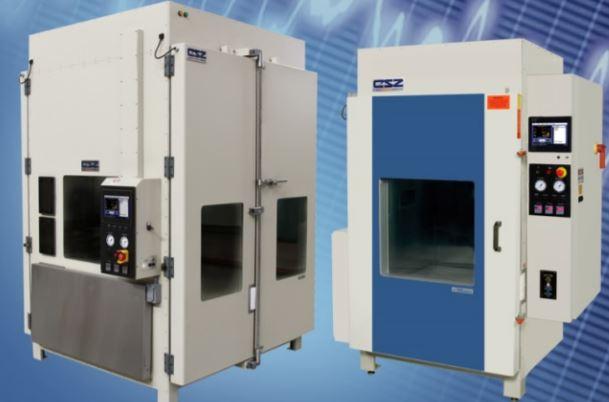
What is HALT and HASS testing?
14:56 - 17/11/2021
No manufacturer wants the customer to be the first to discover any weaknesses in its products. Nevertheless, the siren song of cost reduction often lures companies into performing only minimal compliance-type product testing, even though years of evidence show that almost every problem identified in accelerated life testing could eventually appear in the field. Highly Accelerated Life Test (HALT) and Highly Accelerated Stress Screening (HASS)
Guide to choose Thermal shock test chamber
How to choose Temperature & Humidity test chamber?
Why do we need HALT and HASS testing?
No manufacturer wants the customer to be the first to discover any weaknesses in its products. Nevertheless, the siren song of cost reduction often lures companies into performing only minimal compliance-type product testing, even though years of evidence show that almost every problem identified in accelerated life testing could eventually appear in the field. Highly Accelerated Life Test (HALT) and Highly Accelerated Stress Screening (HASS) uncover product weaknesses so effectively that manufacturers often consider them a major competitive advantage and don’t divulge that they perform HALT/HASS testing or share with the market what they have learned.
Compliance testing is wholly different than accelerated life and stress testing provided by HALT and HASS. Compliance tests demonstrate only sufficiency rather than finding and fixing problems, and as they subject a product to only one stress type at a time, product failure modes and design weaknesses can take months to discover, if they are found at all. HALT and HASS can reduce this process to hours or days.
In addition, the “real world” typically exposes products to all or many stresses at once rather than one at a time, so while one design fault may appear very quickly from vibration testing, another might reveal itself much later from temperature cycling. In short, compliance testing cannot always simulate “real-world” environments or achieve the benefits of the accelerated “test-to-failure” approach of HALT and HASS.
Not surprisingly, HALT and HASS have long been used in electronics, automotive, aerospace, defense, and space markets in which there is zero tolerance for failure. That said, they are also equally well-suited for virtually any type of mechanical, electromechanical, or electronic component or system.
HALT and HASS in a Nutshell
The key benefits of HALT and HASS (Table 1) are realized when products are exposed to multiple stresses in environmental simulation chambers where monitoring is continuously performed and the results are recorded. HALT and HASS shorten the time required to identify potential causes of failure by applying much higher stresses than exist in actual product use. This forces failures to occur in much less time than under normal conditions, revealing how robust a product really is. Rather than compliance (pass/fail) tests, typically limited by component or product specifications, they are “discovery and optimization” processes, based on the goal of ensuring that a product will be a more mature product when it is introduced. Their basic premise is that if a product and its manufacturing process are properly designed, the products that emerge should be exceptionally reliable and deliver unwavering performance over their operating lives.
Benefits of HALT and HASS
When weaknesses and failure modes and their causes are revealed by HALT, corrective action can quickly be taken in development when it is much less expensive and before the company’s reputation is tarnished by failures in the field. Failure-prone components can then be redesigned and tests continued until no more failures occur. The information gleaned from HALT results in a “HALT profile” that is used to develop a screen for later use in HASS. HALT exposes products to extreme high and low temperatures, rapid temperature cycling, and vibration alone and in combination, depending on the specific situation. Humidity testing is also often performed in a separate environmental chamber. The result is rapid discovery of inherent design weaknesses and failure modes so the speed of the product development process can be increased at relatively low cost.
In some cases, defects such as plated throughhole cracked solder joints only appear when subjected to very low stress levels, often vibration. For this reason, CSZ HALT chambers provide very low vibration levels to help discover them.
Benefits of HALT | Benefits of HASS |
Identifies design weaknesses ealier in product lifecycle reducing development time and cost | Detects failures caused by poor workmanship or manufacturing processes |
Speeds time to market | Verifies intergrity of mechanical interconnect |
Ensures product quality and reliability | Prevents flawed units from reaching the customer |
Delivers a more reliable product to market | Detects changes in components and processes and process-related variations in manufacturing |
Ensures higher MTBF | Uncovers problems caused by changes to both software and firmware |
Reduces manufacturing screening costs | Uncovers component supplier quality issues and revision change and even counterfeit parts |
Reduces warranty costs | Reduces warranty costs |
Table 1
HASS uses equipment like that of HALT and relies on information developed to produce the HALT profile. It is performed after HALT has been conducted to determine if any weakness has appeared since those tests were performed. It can also determine the impact that alternative components will have on product design and durability. Without performing HASS, process changes that may have been implemented after HALT are likely to show up as early-life failures in the field.
During the HASS, the information learned from HALT, along with thermal, vibration, and other stress limits are set between the extreme failure points demonstrated by HALT and normal operating limits. The objective is to apply limited stress to the product to reduce the possibility of customers receiving products that are either “dead on arrival” or have unacceptable levels of performance. The limits used by HASS are typically reviewed during a product’s entire production life to safeguard it from being either stressed too little or too much, the former resulting in immediate or early failure and the latter resulting in reduced operating life. Stress levels used in HASS are about half that of HALT but greater than a product will experience in service because it is performed on actual production products, so testing only to the degree at which faults occur ensures that their lifetimes are not reduced.
While environmental test chambers for HALT and HASS are effective for discovery, there are many other types that serve compliance testing, each tailored for the stresses to be applied, the size of the product under test, and other factors. The chambers range from compact reach-in chambers for testing small components that allow virtually any environment to be created, to walk-in (or drive-in) types large enough to walk inside or accommodate a vehicle. Thermal shock chambers in various sizes rapidly move the device under test from one temperature to another, thermally shocking and stressing products under test.
Summary
There are strong arguments for making HALT a mandatory requirement, as it is the fastest, most accurate and cost-effective way to ensure both the overall product quality and the reputation of the company that manufactures
it. HASS extends this assurance throughout the time a product is available for sale. Without them, there can be no certainty that unexpected failures and decreases in performance will not occur, usually reported by
the customer, which can require design changes whose costs can be far greater than the testing that could have prevented them. The best HALT and HASS feedback is always going to be provided by the best HALT and HASS test chambers. Contact us to learn more about our HALT & HASS test chambers..
Source: CSZ Industrial
